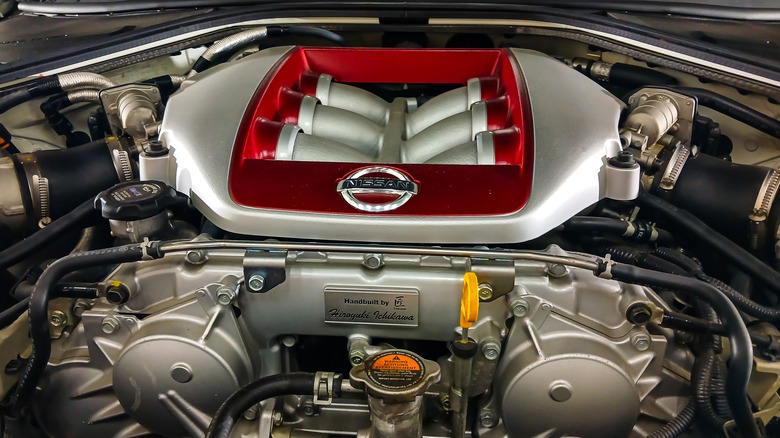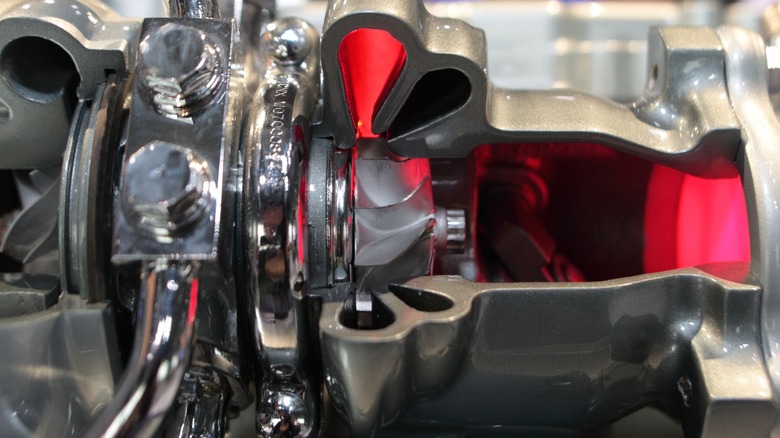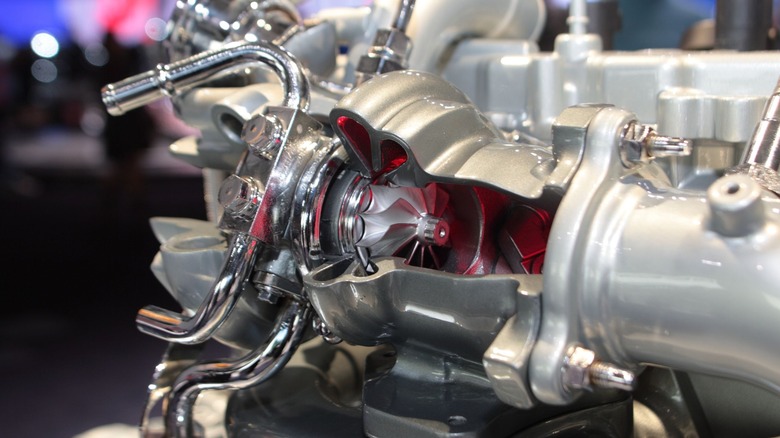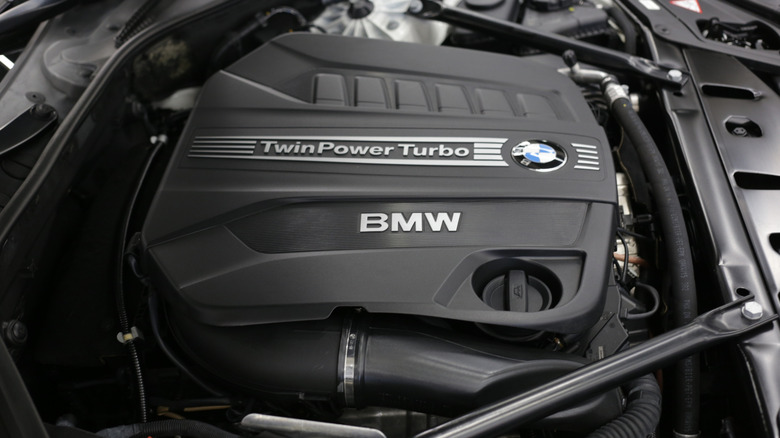What Is A Twin Scroll Turbo, And How Much Horsepower Does It Add?
Automobiles, as any mechanic will tell you, are complicated beasts. Enthusiasts, of course, will have a solid grasp of the jargon. They'll know at a glance what the unusual shape on that road sign means, whether a manual or automatic transmission is best suited to their driving habits, and how a GVW differs from a GCW. Some things, however, seem almost designed to trip you up, like a sneaky trick question in a pop quiz. A twin-turbo and a twin-scroll turbo, for instance, can easily be confused for each other as they're both very similar — and very different.
A twin-turbo, as speed-hungry petrolheads will know, starts with a pair of turbochargers. These components are convenient ways of boosting a vehicle's power and performance, using forced induction through a pump — via a high-speed turbine — to increase the amount of air that the engine has access to. Using the concept of "two turbochargers are better than one," a twin turbo is exactly what it sounds like: a dual-turbocharger arrangement for an engine. A twin-scroll turbo, by contrast, refers to a unique type of turbocharger, one that essentially performs the job of two through its unique twin-channel design, which funnels exhaust through two channels instead of one.
Let's take a closer look at how a twin-scroll turbocharger works in a vehicle's engine, the differences between a twin-turbo and twin-scroll turbo, and the end result in terms of the horsepower the latter can add.
The differences between a twin turbo and a twin scroll turbo
A twin-turbo is an arrangement whereby an engine is equipped with a pair of turbochargers. This type of setup was first sported by the potent-yet-largely-forgotten Maserati Biturbo (pictured above), which arrived in the United States in 1984. The industry has boldly gone beyond this territory, too, venturing into the triple-turbo realm and even the quad-turbo (Bugatti's innovative Veyron, a hypercar marvel in 2005, was the first ever quad-turbo) and beyond. Practicality, however, dictates that simply festooning an engine with as many turbochargers as possible isn't the way forward.
The twin-turbo setup is a neat configuration that sees the exhaust gas led by two different channels via a pair of turbochargers. Sharing the load in this way, they work the magic of a turbocharger to boost the engine's performance. To accomplish this, they're arranged in a variety of ways. Typical twin-turbo engines may deliver exhaust from one turbocharger to another in the twin-turbo series arrangement, ensuring that air is compressed by one turbocharger and then the other. Normally, though, a twin-turbo is often regarded as a pair of turbochargers working side by side in the engine of a vehicle.
A twin-scroll turbo, on the other hand, is a single turbo that's designed to do that same job, with a body split into two such channels. There are several benefits to this arrangement over dividing the job between two separate turbochargers.
How a twin-scroll turbo works
The fact is, turbochargers — not to be confused with superchargers — aren't simple upgrades for a given vehicle. They have significant advantages, and the yields can be great, but there have always been real downsides to them as well. For example, a turbocharger is a complicated component, one that makes a vehicle more vulnerable to mechanical issues and the potential need for costly repairs. Turbochargers also became known for overheating issues and the delay in their functionality when they were first introduced.
Turbo lag is a significant problem that conventional turbochargers face. The reason why the delay occurs is that the turbine that powers the turbocharger needs to build towards a full spin, and so cannot operate immediately. The benefit of the turbocharger, then, isn't constant, so a turbocharged engine isn't as consistently efficient as it could be. The goal of a twin-scroll, as such, is to improve efficiency with a design that may reduce the impact of turbo lag (primarily through the comparatively smaller size of its scrolls), though it is very difficult to remove from the equation entirely.
The twin-scroll turbo is a unique design that operates a bit differently from conventional turbochargers. Essentially, it's a more advanced internal design, with the twin-scroll element of the name referring to the dual "scrolls" contained within. These scrolls are grooves through which the exhaust stream travels to where it needs to be. The bigger of the two delivers to the turbine, while its smaller sibling channels it to the inside edge.
How much horsepower can a twin-scroll turbo add to a vehicle?
This, really, is the most important factor to consider for many. Seeing numbers go brrrrr is one of the greatest thrills for true petrolheads, and a twin-scroll turbo can considerably boost one of our favorite specs of all: horsepower.
It's hard to define exactly how much a twin-turbo can boost a vehicle's horsepower at any given moment because there are so many variables involved in the equation. One fascinating comparison, though, is that between a single-scroll and twin-scroll turbo's performance at different RPMs.
In February 2016, DSPORT Magazine ran a comparison between the two using a KA24DET E85 engine, and they found a stark difference between the use of a twin-scroll and a single-scroll turbine housing. In terms of third-gear pull, at an RPM of 4,500, the engine achieved a horsepower of 248.92. By comparison, the single-scroll option powered it to 205.50. This is a difference of 21.13% more horsepower (or 43.42), the highest recorded across the range tested. The test ranged from RPM levels from 3,000 to 7,000, in increments of 500, and finally to 7,400. The improvement in horsepower ranged from the aforementioned 21.13% down to a difference of just 611.90 versus 610.86 (0.17%), but the twin-scroll always fared better. How much horsepower a twin-scroll turbo can add, then, is very much dependent on what the engine's doing at the time.
Further advantages of a twin-scroll over a single-scroll turbo
DSport's testing also concluded that a half-second reduction in turbo lag or more was achieved by the twin-scroll arrangement. A twin-scroll is able to achieve this because its architecture results in dual streams of exhaust, and this division helps stop them from interfering with each other. In the context of a turbocharger, interference greatly affects efficiency by "staggering" the gases in their journey through the turbine, and the action of the twin-scroll reduces this.
Of course, it isn't always easy to see exactly how a boost in horsepower translates to improved performance. Let's take another favorite stat of many an auto enthusiast: The 0-60, or, rather, acceleration as a whole. DSport also measured the test vehicle's time to accelerate from 45 to 80 mph and from 60 to 100 mph, in third gear in both cases. Here, they found another universal success for the twin-scroll; in the first case, it achieved a time of 2.93 seconds to the single-scroll's 3.24 seconds, and in the latter, the twin-scroll's 1.75 seconds won out by 0.23 seconds.
DSport's report noted that while the improvement was clear to see, overall, it wasn't as stark across the full range (nor was it expected to be). "At 4,500 RPM, that large percentage increase translated into an additional 50.7 lb-ft of torque and 43.4 horsepower at the wheels," it stated.
From twin scroll to twin-twin scroll
Though a twin-scroll turbocharger benefits from greater all-around efficiency than a setup consisting of two single-channel turbochargers, there's something else to consider: What happens if you implement a second twin-scroll?
Where practical, such an arrangement can prove potent, indeed. In 2019, McLaren unleashed one of its most formidable models to date: the new Senna. The car's M840TR V8 engine was equipped with almost 800 bhp, making it a true force to be reckoned with. In fact, it featured more power than any road-going machine the company had produced yet, and one unique aspect of its design was its two advanced turbochargers: twin-scroll designs with electronic waste gates. This twin-twin scroll turbo engine has also been seen in other advanced speedsters such as Ferrari's 488 GTB. "The newly turbocharged sports car makes far more power and torque than its naturally aspirated predecessor," Top Gear reported in August 2015.
Turbocharger technology continues to evolve, as evidenced by BMW — the maker of some very reliable turbocharged engines — and its TwinPower Turbo tech. In a 2009 press release, the automaker announced the application of this technology, stating that "in comparison with the straight-six featuring Twin Turbo technology and High Precision Injection already featured in several model series, the engine at the same time offers a further reduction of fuel consumption by up to 9 [percent]." Power, efficiency, and environmental concerns combine to make twin-scroll turbo technology a huge priority for the auto world.





